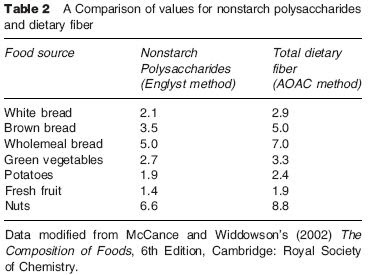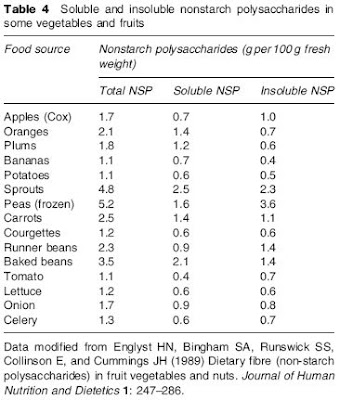The main sources of dietary fiber in most Western diets are well characterized, and high-quality data are available for both food composition and dietary intakes. This is not always true for diets in developing countries, however, and this problem bedevils attempts to investigate the importance of fiber by making international comparisons of diet and disease. Another problem is that different analytical approaches give slightly different values for the dietary fiber content of foods, and do not reflect the physical and chemical properties of the different polysaccharide components.
The use of enzymic hydrolysis to determine the ‘unavailable carbohydrate’ content of foods was refined by Southgate, and his technique was used for the 4th edition of the UK standard food tables, The Composition of Foods published in 1978. The 6th edition, published in 2002, contains values for nonstarch polysaccharides, derived using the Englyst technique, but recommends use of AOAC methods for food labeling purposes. A comparison of values for nonstarch polysaccharides and dietary fiber values obtained
by the AOAC method is given in Table 2.
In the UK about 47% of dietary fiber is obtained from cereal products, including bread and breakfast cereals. The level of cell wall polysaccharides in a product made from flour depends on the extraction rate, which is the proportion of the original grain present in the flour after milling. Thus a ‘white’ flour with an extraction rate of 70% usually contains about 3% NSP, whereas a ‘wholemeal’ flour with an extraction rate of 100% contains about 10% NSP. The terms ‘soluble’ and ‘insoluble’ fiber have been coined in order to partially overcome the problem of the lack of correspondence between the total analytical value for fiber and the physical properties of the measured polysaccharides.
By adopting the Englyst technique for the separation and chemical analysis of nonstarch polysaccharides it is possible to specify both the soluble and insoluble fiber content of foods. Some representative values for soluble and insoluble fiber in cereal foods are given in Table 3, and those for fruits and vegetables, which provide a further 45% of the fiber in UK diets, are given in Table 4.
Salam
Source: Guide to Nutrition Supplements
Image: howmuchfiberday.org









1 comments:
Thanks for the ideal post...When people talk about dietary fiber, they without any delay imagine of older folks taking important dietary fiber. The important points is, suitable fiber intake can benefit all people at any age. Fiber intake may also assist ease digestion and it may possibly also decrease cholestrerol levels, which can be a major result in of heart illness, earning it a really effective, multi-purpose treatment for healthier living. Dietary Fiber Market
Post a Comment